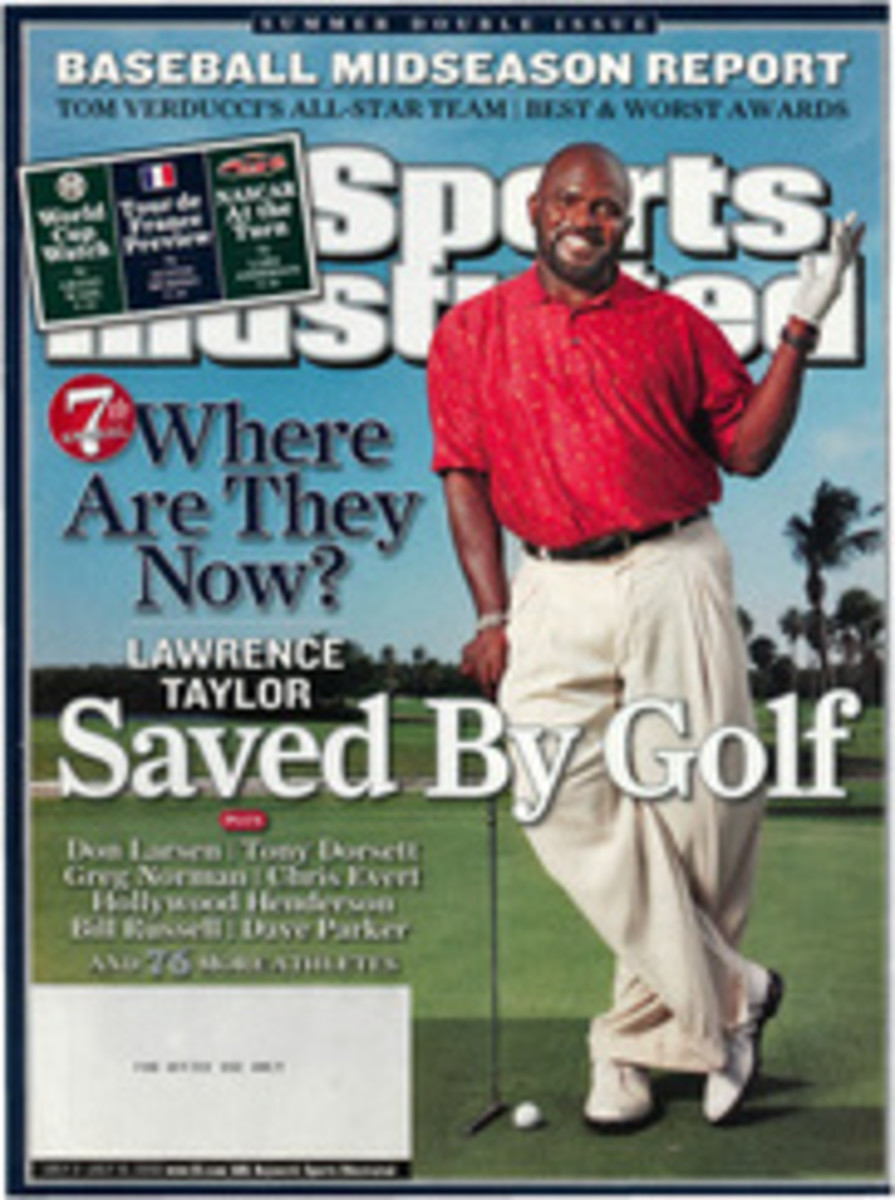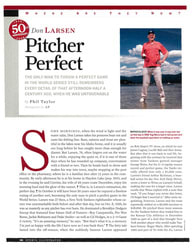
San Francisco DONS - In Their Own Style
You'd think thedetails would be fuzzy after half a century, that all those victories wouldhave blurred together. But they haven't for Bill Russell, who played center onthe University of San Francisco basketball team that won back-to-back NCAAtitles and had a winning streak that stretched to a then record 60 games.Russell recently bought a tape of Win Number 24 on eBay. It was the Dons' onlyclose call of that streak, a 57--56 victory over Oregon State in the WesternRegional final of the 1955 NCAA tournament. Sandwiched between the Beavers' two7-footers, the 6'10" Russell scored 29 points. Watching the game film withhis wife, Marilyn, he surprised her by calling every play before ithappened.
Oregon State coach Slats Gill would say that was "the best game any team ofmine ever played," yet it was not enough to beat the Dons. During the1955--56 season, in the era before the shot clock and the three-pointer, USFaveraged 72 points while holding opponents to 52. The margin would have beenfar wider had a desperate Cal team not held the ball for eight excruciatingminutes during USF's record-breaking 40th straight win and had coach PhilWoolpert let Russell, who averaged 20.5 points and 20.1 rebounds, play morethan 24 minutes a game.
"Russellcould have scored 35 to 40 points anytime he wanted," says Carl Boldt, a6'5" junior starting forward on that team. "But Phil didn't want to runup the score. He never really let us loose."
The Dons were theforerunners for the modern game--in two short years they shifted collegebasketball's balance of power from white to black, from offense to defense and,thanks to the backboard-clearing, shot blocking, backward-dunking Russell, fromhorizontal to vertical. "We changed the game," Russell told SI's FrankDeford in a recent interview. "I think you can even say we developed awhole new philosophy of basketball. We attacked the offense and made it reactto the defense."
The Dons wereunlikely agents of change. The squad, made up almost entirely of players fromthe Bay Area, represented a small Jesuit school that had no gym (practices wereheld at nearby St. Ignatius High). The Dons had won the 1949 NIT title undercoach Pete Newell, but with Woolpert--a high school coach who reluctantly tookover for Newell (his college roommate) when he left for greener pastures atMichigan State--on the bench they slipped back into obscurity, going 44--48 inhis first four seasons. No one expected much more from the 1954--55 team, whichwas anchored by two juniors, Russell and the 6'2" K.C. Jones, who were bothplaying for the only school that had offered them scholarships.
After winningthree games to start the season, the Dons lost to UCLA 47--40. At practice afew days later starting guard Bill Bush told his teammates they'd be a betterteam if Hal Perry, a 5'10" junior, took his spot in the lineup. Woolpertmade the change, giving the Dons three black starters--unheard of at the time.USF would not lose again for two years.
The Dons' offensewas simple: They had one set play, and their main objective was to balance thefloor. Their focus was defense, but their unusual full-court press was more thecreation of the players and assistant Ross Giudice than of Woolpert. "Coachtaught us how to play defense, but we took it a step further with ourcreativity," says Jones. After the Dons scored, Jones and Perry would herdall ball handlers toward the middle, where the lefthanded Russell loomed"to take care of any mistakes," says Perry. A well-placed swat wouldignite a fast break, which agitated Woolpert.
"He believedabout the fast break like Woody Hayes thought about the forward pass--thatthree things could happen, but two of them were bad," says Russell. "Wenever practiced the fast break. But, of course, we used it from the start ofevery game."
Though Russelland Woolpert later became friends, the two butted heads at USF. "I didn'tget along with Phil as a coach, though I always knew he was a good and decentman," says Russell. "He would watch me jump up and block shots, andthen say, 'But that's not the way it's supposed to be done. A defensive man isnot supposed to leave his feet.'"
Woolpert was lessconventional when it came to the racial makeup of his lineup. In addition tothe starting trio, two other black players, Gene Brown and Warren Baxter, wereamong the first three off the bench. "Not to take anything away from TexasWestern," says former Dons forward Mike Farmer, referring to the all-blackstarting lineup that beat an all-white Kentucky team for the 1966 NCAA title,"but USF made the real breakthrough racially."
Woolpert'splayers didn't know about the hate mail he received until years later, thoughthey got a taste of how unpopular his strategy was when they played in stateswhere segregation still ruled. At the All-College tournament in Oklahoma Cityin December of '54, the black players weren't allowed in downtown hotels, sothe entire team stayed in dorms. As the Dons practiced before one game, fanschanted, "Globetrotters!" and threw coins onto the court. "I wasn'toffended," says Russell, who collected the money and put it in hispocket.
Even Woolpert'scritics had to concede that he was on to something when the Dons beat defendingchampion La Salle in the 1955 NCAA title game. That win set the stage for thevictory tour of 1955--56. "We were like rock stars," says Boldt."Every place we played, we packed [them in]." The Dons beat Iowa 83--71to repeat and become the first undefeated team in NCAA history. Russell grabbed50 rebounds in that Final Four, including 27 in the championship game. Bothmarks are still records. (Russell's influence can still be found in the rulebook too. The lane was widened from six feet to 12 feet in 1955, and offensivegoaltending was banned the following year.)
The 1956--57squad won five more games before USF's run ended, unofficially, in Chicagoagainst the U.S. Olympic team, which featured Russell and Jones. On Dec. 17,during that same road trip, Illinois made it official, beating the Dons 62--33to end the streak two years to the day after it started. USF returned to theFinal Four that year, where it lost to Kansas and Wilt Chamberlain in thesemis.
Woolpert, whowould be inducted into the Basketball Hall of Fame posthumously in 1992,resigned from USF in '59 and spent a decade coaching at the University of SanDiego before becoming a school bus driver in Sequim, Wash.
Russell andJones, of course, went on to Hall of Fame careers with the Boston Celtics, whowon eight NBA titles in the nine years the two played together. It wasn't sucha tough transition, says Jones. "By the time we got up there, we knew alittle something about winning."
The '56 Dons
TOM NELSON, C
Semiretired insurance lawyer and a civil litigator, Los Altos, Calif.
GENE BROWN, G
Retired San Francisco police officer and youth counselor, Pittsburg, Calif.
MIKE FARMER, F
Played in NBA (1958-66); adjunct professor at USF, Santa Rosa, Calif.
CARL BOLDT, F
Distributes Cafe Chic, a gourmet coffee from Costa Rica, Arcadia, Calif.
MIKE PREASEAU, F
Retired; owned The Cooking Gallery, a gourmet cookware store, Truckee,Calif.
PHIL WOOLPERT, COACH
Died in 1987 of lung cancer; inducted into Basketball Hall of Fame in 1992
VINCE BOYLE, C
Retired high school teacher and coach, San Rafael, Calif.
JOHN KOLJIAN, F
Retired real estate executive, Walnut Creek, Calif.
BILL RUSSELL, C
Inducted into Basketball Hall of Fame in 1975, Mercer Island, Wash.
BILL BUSH, G
Retired civil litigation attorney, San Francisco
K.C. JONES, G
Assistant to University of Hartford athletic director, West Hartford, Conn.
BILL MULHOLLAND, Manager
Retired assistant school superintendent, Chico, Calif.
WARREN BAXTER, G
Retired city recreation supervisor, San Francisco and Palestine, Texas
HAL PAYNE, G
Retired railroad conductor, Rio Rancho, N.Mex.
JACK KING, F
Semiretired civil litigation attorney, Petaluma, Calif.
HAL PERRY, G
Retired civil rights attorney, El Cerrito, Calif.
STEVE BALCHIOS, F
Retired middle school teacher and coach, San Bruno, Calif.
"Not to take anything away from TexasWestern," says Farmer, "but [the 1955] USF [team] made the realBREAKTHROUGH RACIALLY."
PHOTO
Photograph Courtesy of USF
DON OFAN ERA USF and the lightly recruited Russell (inset) were unlikelypioneers.
Back Row From Left: TOM NELSON, C - GENE BROWN, G - MIKE FARMER, F - CARLBOLDT, F - MIKE PREASEAU, F
Center Row From Left: PHIL WOOLPERT, COACH - VINCE BOYLE, C - JOHN KOLJIAN, F -BILL RUSSELL, C - BILL BUSH, G - K.C. JONES, G - BILL MULHOLLAND, Manager
Bottom Row From Left: WARREN BAXTER, G - HAL PAYNE, G - JACK KING, F - HALPERRY, G - STEVE BALCHIOS, F 
PHOTO
JOE MURPHY/NBAE/GETTY IMAGES (RUSSELL)
[Seecaption above]
PHOTO
UPI BETTMANN CORBIS
THECENTER WILL HOLD The Dons' simple offense revolved around the 6'10" Russell(6) dominating low and Jones (4, inset) leading the break.
PHOTO
BRAD BARKET/GETTY IMAGES(JONES)
[Seecaption above] 

